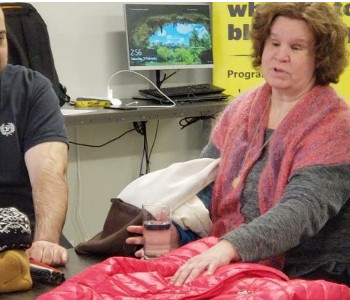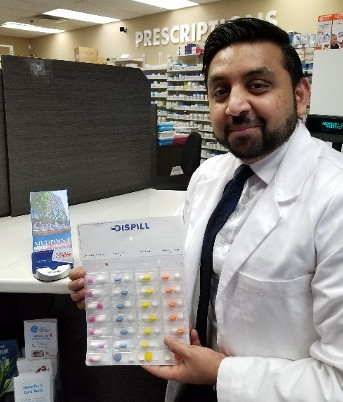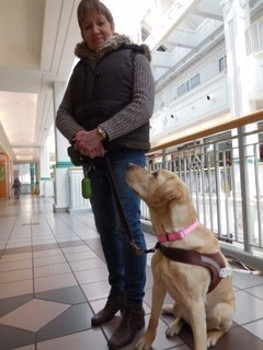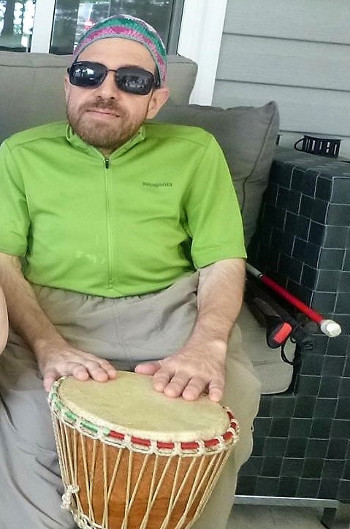Welcome to the March edition of Equalize. In this issue, municipalities receive provincial funding to make public transit more accessible. We learn how students are smashing accessibility barriers in their neighbourhoods. A London pharmacist tells us how he's using braille, and a councillor with the Town of Puslinch gives a shout-out to the enablers. We also hear from Deloitte Canada, a partner with the CNIB Foundation's Come to Work program, about inclusive workplaces. We're also asking you to share your thoughts on the impact of connected and autonomous vehicles for pedestrians with sight loss. And, we take a moment to honour Bill Vastis, a passionate advocate, loyal mentor and devoted CNIB Lake Joe team member. He passed away on January 22.
-CNIB Foundation Ontario Advocacy Team
Province steps on the gas to make public transit more accessible
In January, the Minister of Transportation announced the province will provide funding to 107 municipalities across Ontario to expand or improve their public transit systems via revenue from the Ontario gas tax program. This is based on revenues of two cents per litre on each litre of gasoline sold in Ontario. In total, the province will be transferring $364 million – distribution will be based on population and transit ridership.
 This funding is an exceptional opportunity for people with disabilities, as municipalities have been given a list of transit infrastructure improvement criteria that they can spend the funding on, including accessibility features for public transit.
This funding is an exceptional opportunity for people with disabilities, as municipalities have been given a list of transit infrastructure improvement criteria that they can spend the funding on, including accessibility features for public transit.
CNIB has written to many of the municipalities with meeting requests. Our goal is to provide local advocates with an opportunity to discuss some of the improvements that can be made in their communities regarding public transit accessibility. And, we hope these meetings open doors to broader conversations about accessibility and inclusion.
Get Involved!
Meetings are already underway with different municipalities across the province to discuss some ideas that'll improve accessibility of public transit. This includes tactile identification of bus stop poles, pre-boarding and on-boarding audio announcements, and specific wayfinding technologies that help guide riders to designated areas such as bus bays and stops.
If you have an idea, please email us at advocacy@cnib.ca. Remember to include which municipality you live in.
Understanding the impact of connected and autonomous vehicles for pedestrians with sight loss
In the coming years, city streets and highways will have more and more connected and autonomous vehicles. Connected vehicles rely on an internet connection to share data with other cars, drivers, and infrastructure, while autonomous vehicles are self-driving. We are still several years away from people who are blind being able to independently operate their own car. However, barriers may arise if policy makers, automotive manufacturers and high-tech companies neglect to consider how persons with sight loss navigate the built environment. We have an opportunity to offer input by putting our own lens on the development of standards and regulations while connected and autonomous vehicles are in the early stages.
 With partial funding from Transport Canada, CNIB has developed a short survey to try to understand perceptions of automated vehicles for people with sight loss. We are also looking for information that will help us better understand how people interact with the infrastructure and the mobility aids they use.
With partial funding from Transport Canada, CNIB has developed a short survey to try to understand perceptions of automated vehicles for people with sight loss. We are also looking for information that will help us better understand how people interact with the infrastructure and the mobility aids they use.
We are asking you to share your thoughts before the end of April. You'll find the survey at surveygizmo.com/s3/4635306/CNIB-CAV-project.
Please feel free to share the survey with others in your networks, so we can receive the most comprehensive results possible!
CNIB works with City of Ottawa and OC Transpo ahead of Light Rail Transit (LRT) launch
CNIB continues to work with the City of Ottawa and OC Transpo as they prepare for the launch of the new Light Rail Transit (LRT). Stage 1 of the Confederation Line O-Train will span 12.5 km and consist of 13 stations as well as a tunnel through Ottawa's downtown core. In preparation for this, we have been working with OC Transpo on various aspects that will impact accessibility for transit riders who are blind or partially sighted.
In December, we provided feedback on the proposed decals for the sides of the glass bus shelters. In February, we weighed in on the tactile and braille signage that will be used at each bus stop. The signage sample sent from OC Transpo was assessed by Vision Loss Rehabilitation Ontario (VLRO) staff, including an orientation and mobility specialist and independent living specialist. The VLRO team is also working with OC Transpo to gain advance access to LRT stations to provide training for riders who are blind or partially sighted to ensure safe navigation – timelines still need to be confirmed.
Finally, we have been working with OC Transpo to coordinate the implementation of new transit passes called A-Cards. These cards, with tap capability, will be used on all forms of transit in Ottawa: bus, existing O-Train, and future LRT.
Students smash accessibility barriers in their neighbourhood
Smashing barriers and emboldening people who are blind or partially sighted to lead independent, active lives is not a way of life exclusive to CNIB staff, ambassadors or participants. In January, the CNIB Foundation's advocacy team was approached by two grade 10 students, Dalia Golovco and Maddie Dick, about an urgent accessibility issue in their community of Leslieville.
 After witnessing a local resident with sight loss face challenges with crossing the street, they knew something needed to change. With momentum from their social action project for their civics class, they conducted thorough research on Accessible Pedestrian Signals (APS) systems and reached out to the CNIB Foundation as a key stakeholder. They needed help with executing their plan to confront the municipal government about this issue. Dalia and Maddie also developed multiple petitions that were signed by a plethora of concerned community members, including those with sight loss. To ensure their success, both students met with Brittany Manu, Team Lead, Advocacy & Community Engagement and Debbie Gillespie, Lead, Built Environment and Transit Advocacy. In their words:
After witnessing a local resident with sight loss face challenges with crossing the street, they knew something needed to change. With momentum from their social action project for their civics class, they conducted thorough research on Accessible Pedestrian Signals (APS) systems and reached out to the CNIB Foundation as a key stakeholder. They needed help with executing their plan to confront the municipal government about this issue. Dalia and Maddie also developed multiple petitions that were signed by a plethora of concerned community members, including those with sight loss. To ensure their success, both students met with Brittany Manu, Team Lead, Advocacy & Community Engagement and Debbie Gillespie, Lead, Built Environment and Transit Advocacy. In their words:
"Accessibility in Toronto is an issue we both feel needs to be solved urgently. We have decided to focus on implementing new APS systems in Leslieville, which has just three APS systems, despite being a very busy area. We were hoping you would be able to provide us with some information on how APS systems would benefit the blind community in Leslieville. We know you have a lot of expertise on issues that the visually impaired face, and your support for our plan would help enormously…"
Their advocacy efforts and preparation landed them a prompt in-person meeting with Councillor Paula Fletcher of Ward 14 Toronto-Danforth. Ramla Abukar, Coordinator, Advocacy and Community Engagement, CNIB Foundation was invited to attend – she provided context and shared her perspective as someone living with sight loss. Impressed with their determination, the councillor personally promised to support their efforts – she is working with these leaders to install multiple APS systems at high-risk areas identified by both Dalia and Maddie.
While working together to achieve remarkable results, these young advocates are smashing barriers to accessibility and inclusion.
Waterloo students bring smart cane to London
In February, CNIB Foundation participants gathered at the London Community Hub to meet the Sonar Team, an ambitious group of Waterloo high school students who are designing a smart cane to enhance the independence of people who are blind or partially sighted. Their prototype, a vest featuring vibrating sensors that alert the wearer to upcoming obstacles, isn't the first of its kind, so participants were eager to provide feedback and help these talented teens improve their product.
 Participants took turns trying on the vest to get a feel for how it works. While the feedback was mostly positive, participants noted that the vest can't detect obstacles to lower parts of the body, such as a bench or a chair. Participants were happy to share their day-to-day experiences as cane users and provide insights about what it's like to navigate the world with limited sight. They also discussed similar products that are currently on the market and offered suggestions to help the Sonar Team rise above the competition.
Participants took turns trying on the vest to get a feel for how it works. While the feedback was mostly positive, participants noted that the vest can't detect obstacles to lower parts of the body, such as a bench or a chair. Participants were happy to share their day-to-day experiences as cane users and provide insights about what it's like to navigate the world with limited sight. They also discussed similar products that are currently on the market and offered suggestions to help the Sonar Team rise above the competition.
We look forward to welcoming the Sonar Team back to the London Community Hub to check out the next phase of their prototype.
Pharmacy using braille to help customers manage medications
In a world where technology is making our lives easier, sometimes it's the simplest solution that's the most effective. Medpoint Care Pharmacy, in downtown London, stumbled upon a much-needed offering. Nauman Shaikh, Manager and Owner, noticed some raised markings on the outside of a medication box. He reached out to the manufacturer to find out what they were. To his surprise, he learned that the raised dots were braille.
 By a happy coincidence, Mr. Shaikh and the Medpoint Care team started to notice braille on more and more packages around the store. Mr. Shaikh also noticed these markings along with colour coding on the blister packs he prepares for patients. The pharmacy creates blister packs with a combination of medications, so it's easier and safer for patients to take their medications.
By a happy coincidence, Mr. Shaikh and the Medpoint Care team started to notice braille on more and more packages around the store. Mr. Shaikh also noticed these markings along with colour coding on the blister packs he prepares for patients. The pharmacy creates blister packs with a combination of medications, so it's easier and safer for patients to take their medications.
After reading a study, Mr. Shaikh learned nearly 50 per cent of Canadians don't take their medications properly. With so many unrecognized barriers, such as most tablets being manufactured as colourless or white, this braille and colour coding system will go a long way in assisting people who are blind or partially sighted with taking their medications.
"It is most important for patients to know how and why they are taking their medication," says Mr. Shaikh. If they don't even know what they're taking, it can be dangerous."
Deloitte Canada joins the CNIB Foundation's Come to Work program
The CNIB Foundation's Come to Work program introduces employers to an innovative talent pool of Canadians who are blind or partially sighted and provides job seekers with work experience.
Come to Work partners are committed to engaging talent with different perspectives to create a culture of collaboration and innovation.
Deloitte Canada is in the process of securing a second internship position for a Come to Work talent pool member. We spoke with Carole Mendonca, Manager, Inclusion, Deloitte Canada about inclusion in the workplace.
What have you learned about employing someone with sight loss?
We have identified gaps within our organization through accommodations, internal processes and infrastructure. We consider this to be a huge benefit as we continue to learn and grow as an inclusive employer. We have now extended the internship and offered a full-time opportunity to one of our interns within the recruitment department!
What has this experience been like for you and your team?
Working alongside someone who is partially sighted has given us a fresh perspective to our firm. We have been learning what it means to be a truly inclusive organization and our intern has helped us do this.
What were the challenges or growing pains that you had to overcome?
We identified accessible technology to be challenging, especially within our accommodation process. This is something we just haven’t been exposed to. Therefore, we realized very quickly that our internal processes needed to change. As we have not had blind or partially sighted employees within our Toronto office, we worked closely with our business operations team to find solutions for our interns to navigate our building.
Deloitte Canada is an official Come to Work partner. Why should other businesses/organizations consider participating in the program?
We have had great pleasure working with the CNIB Foundation through the Come to Work program and truly believe it will greatly benefit other organizations to hire more people who are blind or partially sighted. It’s a great opportunity to share best practices and collaborate with other companies on how to be an inclusive employer and showcase abilities rather than disabilities.
CNIB has provided us with extensive support through awareness training and ongoing touch points which has helped us through this process.
We know that Deloitte Canada is a champion of accessibility and inclusion. In February 2019, Deloitte was honoured with an award at the 35th annual Great Valentine Gala for the Canadian Foundation for Physically Disabled Persons. What would you say to other businesses or organizations about hiring someone with a disability/sight loss?
We believe that in order to be a truly inclusive employer, you need to hire people with disabilities and have a strong focus on talent and abilities. They create a more inclusive environment and provide a perspective that other employees would not have.
When you provide these employees an opportunity to work, they show commitment, gratitude, productivity and loyalty to the company. As we continue to grow and hire more people with disabilities, we encourage other companies to do the same and learn from each other through the process.
Guest Blog: Hats off to enablers
Matthew Bulmer, Councillor, Township of Puslinch
As a farmer who's blind, I have lots to keep me busy each year. From making maple syrup in the spring to harvesting hay in the summer and servicing equipment for winter storage, the farm has a predictable cycle.
 But, 2018 wasn't just about the cycle of farming; it was also the year that I was elected for my fifth term as a councillor in the Township of Puslinch. Most people would consider this an amazing accomplishment for me, but I see it differently.
But, 2018 wasn't just about the cycle of farming; it was also the year that I was elected for my fifth term as a councillor in the Township of Puslinch. Most people would consider this an amazing accomplishment for me, but I see it differently.
For everything I want to accomplish, there is someone willing to enable me to get it done. That's amazing! Unfortunately, our enablers are often hidden in the shadows.
I first noticed this when I still had my sight and saw Jeff Healey, a guitarist who was blind, on TV. Typically, artists would be seen walking across the stage after their performance to sit beside the host. However, in Healey's case, the camera simply cut to a shot of him already seated next to the host. How did he do that? Why did they hide the enabler?
Since then, I have been concerned that when we hide our enablers, it may send the message that accepting help somehow diminishes us. What’s worse is that it gives people the impression that we don’t need help.
I’m proud of my enablers. They are critical to my success, Afterall, everyone needs help with something. So, hats off to the enablers! It’s time for them to share the spotlight when we do something amazing.
Use Your Voice
In the dead of winter, nothing warms the soul more than a cozy evening in front of the TV. For Sharon Ruttan, this means snuggling up with her guide dog, Hominy, to watch the latest episode of Murdock Mysteries in described video. An avid Accessible Media Inc. (AMI) viewer, Sharon knows what works when it comes to describing programming for people with sight loss—and what doesn't.
 "It's about finding the right balance without being intrusive," she says.
"It's about finding the right balance without being intrusive," she says.
In January, Sharon was invited to be a consultant for a described video course in Hamilton. She didn't hesitate to embrace the experience. A long-time volunteer with Shop CNIB and Intern, Community Engagement, CNIB Foundation, Sharon is always ready to embark on a new adventure.
"It was fun," she says, recalling the warm welcome that she and Hominy received from the class.
Over the course of three days, she spent time with each of the 10 students, offering them an insider's perspective on the types and amount of detail that viewers with sight loss expect.
"They wanted feedback on their work," says Sharon. "They would describe short video clips, and I would give them tips on what works for me as a viewer.”
When asked if braving the cold and snow to voice her opinions was worthwhile, Sharon’s response is no surprise.
“Yes,” she says, “I’d happily do it again.”
And now back to your regularly scheduled programming…in described video.
Honouring our dear friend and colleague, Bill Vastis
Often described as the heart and soul of CNIB Lake Joe, Bill Vastis brought people together. He could be found sharing compelling stories around the campfire, creating captivating musical moments with his mandolin in tow, and participating in outdoor adventures and activities in Muskoka.

A passionate advocate, loyal mentor and devoted CNIB Lake Joe team member, Bill passed away on January 22, at the age of 46. Whether you've known Bill for a day or years, the impact is the same. He had an electricity about him that made everyone he met feel special, valued and included. We spoke with Derek Thompson, Member, CNIB Lake Joe Advisory Board about his 30-year friendship with Bill.
"Bill always expressed a desire to live life to the fullest “carpe diem” and never let his physical challenges be obstacles in his pursuits. He personified the phrase “no excuses” and constantly sought adventure and experience – whether in his education, his profession or recreational activities. Bill was probably the most generous man I knew – in giving time, attention, gifts, hope, laughs, inspiration and food. He never showed up anywhere without a smile (or something to eat!) and was always ready to give advice or support without anyone having to ask."
At his funeral service, a note Bill had written was passed around. We lifted a poignant quote from it to share:
"Finally, I’d like to share a few life lessons that I have learned: My itinerant teacher Dorothy Anscombe (who was with me from Grade 3 to graduation) taught me the importance and value of giving back, and this has been a principle that I have tried to live by. People will give a lot of themselves – time, money and love – and it is important to find ways to return such graces to family and friends, our communities and the greater society and humanity at large. This will sound very Jerry Springer-like, but it is true. Kindness is an invaluable gift. Give your time, your attention, your friendship and your love when and where you can. Be kind to one another. We have no idea the impact and reach a little kindness can have."
Well regarded for his advocacy work, dedication, and years of service at CNIB Lake Joe, Bill was a remarkable person who will be remembered for his infectious laugh, megawatt smile, and generous kind nature.
Become a member of the Clinical Trials Ontario’s Patient and Public Advisory Group
Clinical Trials Ontario (CTO) is seeking additional members for its Patient and Public Advisory Group (P2AG). In 2017, CTO created the P2AG to ensure that their activities are informed and improved by the perspectives and advice of patients and the public. They are currently seeking 3-4 new members to join the P2AG. You do not need to know about clinical trials to be involved – if you are interested in clinical trials and live in Ontario, there may be a role for you.
Clinical Trials Ontario is an independent not-for-profit organization established with support from the Government of Ontario. Their mandate is to work with the clinical trials community, the public, and other partners to improve clinical trials in Ontario. Since 2012 they have been carrying out that mandate while keeping one of their three strategic pillars in mind; patient and public engagement. They believe engaging patients and the public is critical to improving the environment for clinical trials in Ontario and will result in better clinical trials, better experiences for trial participants, better physician-researcher experiences, and in the long run, a better health care system. More information about Clinical Trials Ontario can be found at ctontario.ca.
If you are interested in this opportunity, please contact Dawn Richards (dawn.richards@ctontario.ca), CTO’s Director of Patient and Public Engagement including the following information:
- Why you are interested in being part of the P2AG;
- The contribution you could make to the P2AG (skills, experience, or perspectives);
- Any involvement you have with patient or healthcare organizations (this is not a requirement to participate);
- Where you live;
- You may share any other communities you are a part of (e.g., an ethnic or cultural community, LGBTQ, youth)
- Whether you would be interested in remaining connected to CTO even if you are not invited to participate in the P2AG (in this case, your name and email address will be placed on a mailing list). CTO would like to build a community of people who are interested in clinical trials in order share information with them about this topic, such as educational opportunities and websites, interesting research, and other potential opportunities to be involved in research with some of our partners.
